Related Research Articles

An armed merchantman is a merchant ship equipped with guns, usually for defensive purposes, either by design or after the fact. In the days of sail, piracy and privateers, many merchantmen would be routinely armed, especially those engaging in long distance and high value trade.

The German auxiliary cruiser Kormoran (HSK-8) was a Kriegsmarine merchant raider of World War II. Originally the merchant vessel Steiermark ("Styria"), the ship was acquired by the navy following the outbreak of war for conversion into a raider. Administered under the designation Schiff 41, 'Ship 41', to the Allied navies she was known as "Raider G". The largest merchant raider operated by Germany during World War II, Kormoran ("cormorant") was responsible for the destruction of 10 merchant vessels and the capture of an 11th during her year-long career in the Atlantic and Indian oceans.
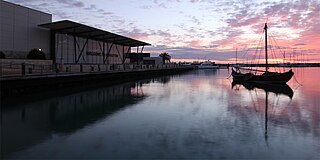
Geraldton is a coastal city in the Mid West region of Western Australia, 424 kilometres (263 mi) north of the state capital, Perth.
Kormoran may refer to:

HMAS Sydney was a Chatham-class light cruiser of the Royal Australian Navy (RAN). Laid down in 1911 and launched in 1912, the cruiser was commissioned into the RAN in 1913.

HMAS Sydney, named for the Australian city of Sydney, was one of three modified Leander-class light cruisers operated by the Royal Australian Navy (RAN). Ordered for the Royal Navy as HMS Phaeton, the cruiser was purchased by the Australian government and renamed prior to her 1934 launch.

The Battle of Cocos was a single-ship action that occurred on 9 November 1914, after the Australian light cruiser HMAS Sydney, under the command of John Glossop, responded to an attack on a communications station at Direction Island by the German light cruiser SMS Emden, commanded by Karl von Müller.

On 19 November 1941, the Australian light cruiser HMAS Sydney and the German auxiliary cruiser Kormoran engaged each other in a battle off the coast of Western Australia. Sydney, with Captain Joseph Burnett commanding, and Kormoran, under Fregattenkapitän Theodor Detmers, encountered each other approximately 106 nautical miles off Dirk Hartog Island. The single-ship action lasted half an hour, and both ships were destroyed.
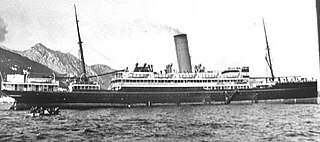
SS Zealandia, nicknamed "Z", was an Australian cargo and passenger steamship. She served as a troopship in both World War I and World War II. Zealandia transported the Australian 8th Division. Her crew were the last Allied personnel to see HMAS Sydney, which was lost with all hands in 1941. Zealandia was sunk in the air raids on Darwin of 19 February 1942.
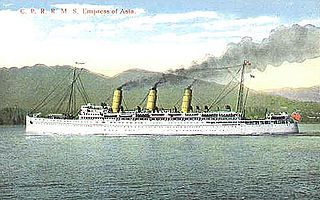
RMS Empress of Asia was an ocean liner built in 1912–1913 by Fairfield Shipbuilding and Engineering at Govan on the Clyde in Scotland for Canadian Pacific Steamships.
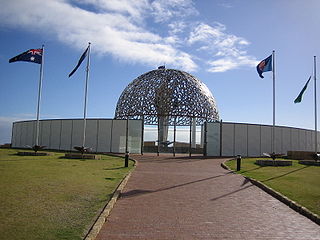
Numerous attempts were made to find the Australian cruiser HMAS Sydney and the German auxiliary cruiser Kormoran, which were both lost in a sea battle in 1941. Efforts immediately after the battle focused on finding Sydney when she failed to return to port. While searchers located over 300 survivors from Kormoran, none of the 645 aboard the Australian warship were found. In March 2008, shipwreck hunter David Mearns commenced a search for the two wrecks. Kormoran was located on 12 March in close proximity to the sinking position given in German accounts. Using the survivor's information on Sydney's last known heading, Mearns and his search team located Sydney on 17 March.

The Bradleys Head Fortification Complex is a heritage-listed former mast and defensive battery and military fortification and now war memorial and recreational area located at Bradleys Head Road within the Sydney Harbour National Park in Mosman in the Mosman Council local government area of New South Wales, Australia. It was designed by Government engineers and built from 1840 to 1934. It is also known as Bradleys Head Forts and HMAS Sydney 1 Mast and Associated Memorials. The property is owned by the NSW Office of Environment and Heritage, an agency of the Government of New South Wales. It was added to the New South Wales State Heritage Register on 30 August 2010.
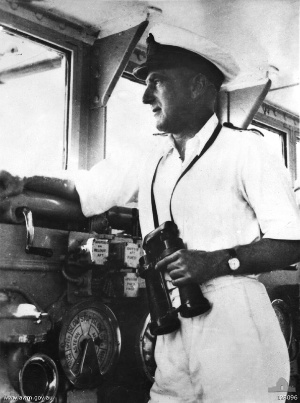
Joseph Burnett was a Royal Australian Navy (RAN) officer most widely known as the captain of the light cruiser HMAS Sydney in the battle between HMAS Sydney and HSK Kormoran on 19 November 1941. He fought in both the First World War and Second World War, serving in the RAN and the Royal Navy (RN), and went down with the Sydney off the coast of Western Australia.

Theodor Detmers was a German naval officer and captain of the German auxiliary cruiser Kormoran during World War II. He was a recipient of the Knight's Cross of the Iron Cross of Nazi Germany. Detmers commanded the commerce raider Kormoran when it sunk the Australian light cruiser HMAS Sydney in a mutually destructive battle.

MV Duntroon was a passenger motor ship built for the Melbourne Steamship Company, that saw military service as a troopship between 1942 and 1949. She was built by Swan, Hunter & Wigham Richardson, Walker, Newcastle upon Tyne, and entered service in 1939.

The Historic Shipwrecks Act 1976 was an Act of the Parliament of Australia which legally protected historic shipwrecks and any relics or artefacts from those wrecks.
The Exploits of the Emden is a 1928 silent Australian film about the Battle of Cocos; the World War I naval battle between Australian cruiser HMAS Sydney and German cruiser SMS Emden. It consists of footage from a 1926 German film, Our Emden, with additional sequences shot in Australia by director Ken G. Hall. Only part of the film survives today.

SMS Emden was the second and final member of the Dresden class of light cruisers built for the German Kaiserliche Marine. Named for the town of Emden, she was laid down at the Kaiserliche Werft in Danzig in 1906. The hull was launched in May 1908, and completed in July 1909. She had one sister ship, Dresden. Like the preceding Königsberg-class cruisers, Emden was armed with ten 10.5 cm (4.1 in) guns and two torpedo tubes.


HMAS Sydney I – SMS Emden Memorial is a heritage-listed former foreign naval ship gun and now war memorial and war trophy located in Hyde Park, on the corner of Liverpool and College Streets in the Sydney central business district, in the City of Sydney local government area of New South Wales, Australia. It was designed by City of Sydney and built from 1917 by Messrs Loveridge and Hudson, Redfern. It is also known as HMAS Sydney 1 - SMS Emden Memorial and Emden Gun. The property is owned by City of Sydney. It was added to the New South Wales State Heritage Register on 27 February 2015.
References
- ↑ "Olson, Wesley (1960–)". trove.nla.gov.au. Retrieved 22 September 2021.
- ↑ "HMAS Sydney (II): In peace and war / Wes Olson". Australian War Memorial. Retrieved 22 September 2021.
- ↑ Olson, Wesley; Olson, Wes (2006), Gallipoli : the Western Australian story, University of Western Australia Press, ISBN 978-1-920694-82-1
- ↑ Butler, Janet (1 December 2008), "Review of Wes Olson's Gallipoli: The Western Australian Story.(Book review)", History Australia, Monash University ePress, 5 (2): 55.1(2), ISSN 1449-0854
- ↑ Clement, Cathie (2011), "Gallipoli: The western Australian story [Book Review]", Studies in Western Australian History (27): 231–232, ISSN 0314-7525
- ↑ "Author Historian Wes Olson with a copy of his". WestPix. Retrieved 22 September 2021.
- ↑ Swinden, Greg (2018), "The last cruise of a German raider: The destruction of SMS [Book Review]", Sabretache, 59 (4): 57–58, ISSN 0048-8933